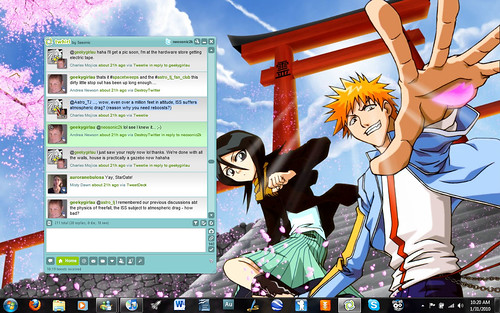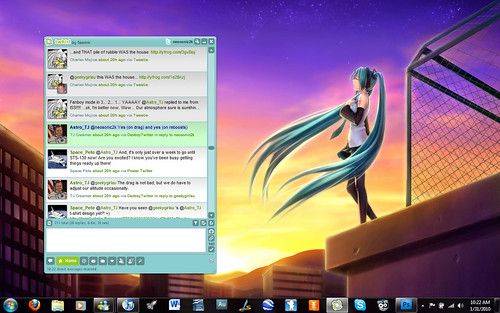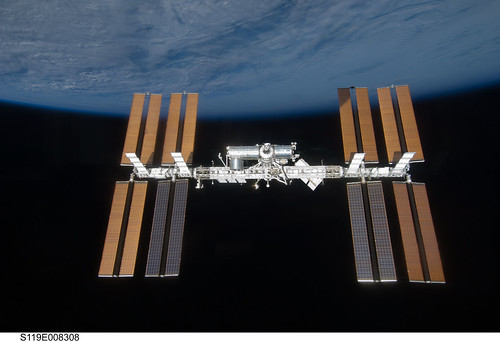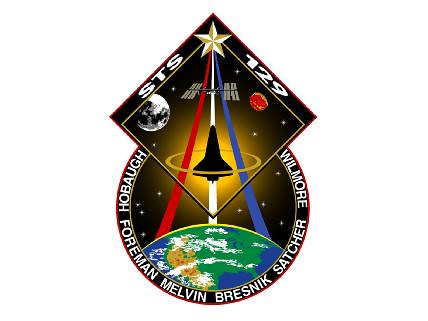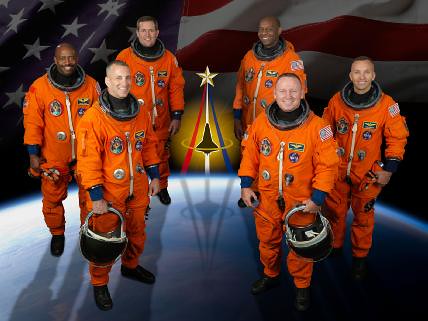So, the shuttle blasts off, reaches orbit, and does its mission, be it working on a satellite, or going to the ISS to deliver parts, either for spare storage or for making the station bigger and more efficient, and to exchange crewmembers. Actually, to date, the last remaining shuttle missions will go to the ISS to resupply it and complete it. There will be no more crew rotations by the shuttle. Crew rotation is now the sole responsibility of the Russian Space Agency and their Soyuz spacecrafts.
So, finally, after a successful mission and the orbiter’s heat shield is cleared for reentry, the mission enters its deorbit preparations phase. Typically, this takes a day, done the day before scheduled deorbit. The astronauts check the flight control system, and makes a hot-fire test of the RCS thrusters, which are critical in controlling the shuttle’s attitude during most of reentry, at least before the airstream is thick enough to be able to use the aerosurfaces. Also, the RMS arm and the OBSS boom is stowed for landing, and the KU band antenna, responsible for high speed data transmissions between the ground, shuttle and station, is deactivated and stowed. Only the regular antennas are used for communications and telemetry.
Remember that NASA has 2 main landing sites and a backup landing site. The first main landing site, and the primary main landing site, is the Shuttle Landing Facility at Kennedy Space Center, Florida. The second, ‘backup’ main landing site is Edwards Air Force Base at California. The actual backup landing site, only used once in all of the space shuttle program, is the White Sands Testing Range in New Mexico.
Finally, the day has arrived. The crew wakes up and immediately jump into action for the return home. Let’s assume, as always, that the shuttle in question is Discovery, and that landing is possible at Kennedy.
DEORBIT PREPARATIONS
The start of the Deorbit Burn, in terms of the countdown to it, is called “Time of Ignition”, or TIG. With that in mind, we start our journey back home.
TIG-4 hours. Final Deorbit preparations start here.
The crew has been briefed about the weather conditions at the landing site, this time at Kennedy Space Center’s Shuttle Landing Facility. The crew executes an alignment of the Inertial Measurement Units used for guidance of the orbiter. They also activate systems that aren’t in use during the mission that support entry and landing operations.
Now, the commander’s and pilot’s seats cannot be removed, but the mission specialist seats, both in the flight deck and the mid-deck, are stowed to increase space within the orbiter (it gets kinda cramped with 6-7 people). At this time, the seats are installed back into their positions.
TIG-3 hours.
“Discovery, you have a Go for Payload Bay Door Closing.”
This means the crew can now close the payload bay doors. Now, the radiators on the doors were stowed before this. They were used to maintain correct thermal conditions for the orbiter’s systems during its mission. Well, how does it maintain it now that the doors will be closed?
Flash Evaporation, that’s what.
During launch, right around the point of SRB separation, the Flash Evaporator System activates and rejects heat from the coolant system by means of water boiling, all the way until the Payload Bay Doors are opened and the radiators are deployed, which take over. From radiator stowage until less than 100,000 feet in altitude, the Flash Evaporator System takes over once again. However, under 100,000 feet, water loses its efficiency to reject heat with this method. The Flash Evaporator switches to ammonia boiling to maintain temperatures until the shuttle lands and the ground cooling system is hooked up to it.
The crew had stowed the radiators, and checked that the flash evaporator system is working correctly, before Mission Control gives a Go for Payload Bay Doors closing. The crew does so, and the doors are closed.
TIG-2 1/2 hours. Roughly around this timeframe, another call is given from Houston.
“Discovery, Houston. You are Go for OPS-3".
The crew starts to set up the shuttle’s GPCs for the deorbit, entry and landing program, called OPS 3. Remember that OPS 1 controlled launch, ascent and stabilization of the orbit, and OPS 2 controlled everything during orbit? OPS 3 will bring them home. Since on-orbit operations isn’t as dynamic as a launch and a landing is, the backup computer, GPC 5, and normally one of the 4 main GPCs, is shut down. At this point, both are re-enabled and configured for OPS 3, and the program is loaded. Now, all GPCs are running on Major Mode OPS 301, the ‘coast to deorbit’ portion of the software. Shortly after, the Star Trackers, used for navigation, two small doors on the front of the orbiter, are closed and deactivated.
TIG-1 hour, 30 minutes. Starting with the Commander and Pilot, the crew begins to put on their bright orange Launch and Entry Suits, actually called the Advanced Crew Escape System. These suits provide them with their own pressurized oxygen supply in the event of cabin pressure loss, and are equipped with survival tools in case of a bailout, including, of course, a parachute and a life raft.
TIG-1 hour. Everyone is ready to get strapped into their seats. A call from Houston confirms that deorbit looks realistic.
“Discovery, Houston. You are go for fluid loading.”
This means that the crew must consume large amounts of liquid and salt tablets. This helps them to adapt better to gravity once they land. The liquids can be water or any kind of drink.
TIG-20 minutes.
The crew is strapped into their seats, and the landing team polls are made. The weather has been assessed, and everything looks great.
“Discovery, Houston. You are go for the deorbit burn.”
This call tells the crew that their trip home is sealed. The pilot and commander transition the GPCs to OPS 302, the “deorbit burn” mode, load the deorbit burn targets and execute the attitude adjustment. The shuttle then changes its attitude so that at the point of deorbit, the shuttle’s engines are aiming at the direction of travel, for the retrograde (backward firing) deorbit burn. The pilot executes the APU (auxiliary power unit) Prestart procedure, putting all 3 APUs ready to start. The APUs are critical to landing, since they will power the hydraulics needed to move the aerosurfaces needed for control of the shuttle in the atmosphere, and for lowering the landing gear for landing.
TIG-3 minutes. The pilot activates one of the 3 APUs needed for landing. Before actually committing the shuttle to reentering the atmosphere, it must be checked that at least one APU works and operates correctly. Only 1 APU is needed for a safe landing. The APU checks out perfectly. The OMS engines are armed, and Mission Control confirms that the shuttle has the correct configuration for the burn. The minutes become seconds, and…
3….2….1…
TIG. OMS Engine Ignition.
DEORBIT AND ENTRY INTERFACE
The deorbit burn commences, and the shuttle begins to slow down from its stable orbital speed as the twin OMS engines fire against the direction of travel. This burn is executed half a world away from the landing site, so that the perigee (lowest point of the orbit) is precisely there. The perigee is dropped all the way to ZERO miles during this burn, and even after that, the burn continues. The burn typically lasts around 3 minutes, depending on the orbit’s height. The commander and pilot see the displays as the burn timer ticks down to zero. After chopping off at least 200MPH off their ~17,500MPH speed, the OMS engines cut off, and they disable the OMS engines for good, as this was their very last job in the mission.
Discovery is now on a decaying orbit, its altitude slowly dropping. It is now committed to land, officially one hour away from landing, and roughly half an hour away from the Entry Interface, the next milestone in landing. Before hitting the atmosphere, the commander and pilot transition the computer to OPS 303, the “coast to EI” mode. At this point, they manually maneuver the shuttle to its correct reentry angle, where it will enter the atmosphere with the nose pitched 40 degrees upwards, the reentry angle of attack. It is done like this so the thermal protection system, the heat tiles, are the ones aiming at the airstream, and to bleed off its tremendous orbital speed by increasing drag.
Moments after they maneuver the shuttle to the correct attitude, the pilot activates the other APUs, and all 3 APUs are running. After that, they do a check of the aerosurfaces, mainly to prime them, to run warm hydraulic fluid through them. The engine nozzles are gimbaled (aimed) to prevent damage to them during reentry. Also, ALL of the Forward RCS fuel is dumped. This is done to prevent pollution of the air when the shuttle lands. The forward RCS jets, as you may have guessed, are not needed for reentry.
5 minutes before Entry Interface, the computers are transitioned to OPS 304, the “entry interface” mode. The shuttle is ready for reentry, and the GPCs assume automatic control of the descent.
Entry Interface begins roughly half an hour away from landing. As Discovery drops below 400,000 feet, it encounters the airstream, a bit at first, then slowly but steadily thickening. Soon, a halo of plasma covers the entire shuttle as friction of the shuttle against the thickening airstream increases. The shuttle is essentially a fireball at this point, streaking down and across the sky like a meteor. Temperatures from the friction can increase up to 2000 degrees Farenheit on the nosecap and wing leading edges at the point of Maximum Heating. The Thermal Protection System is designed to dissipate this tremendous heat and protect the shuttle from burning up.
Of course, Discovery is encountering the thickening airstream. It’s become a fireball. Thanks to the plasma generated by the superheated air coming off the shuttle’s belly from the effects of friction, there are no communications. Only NASA’s Deep Space Network, powered by their Tracking Data and Relay Satellites (TDRS), is still tracking Discovery. But something important is happening. The atmosphere is slowing Discovery down!! As the atmosphere thickens, it creates more and more of a stopping force for Discovery, braking it even further. The speed drops from 17,000MPH… to 16,000… to 14,000…. to 12,000….
However, the GPCs onboard Discovery know that if they maintain this course and angle of attack, by the time they reach a stable flying speed and altitude suitable for landing, they would have overshot the landing site by too many miles. You’re asking yourself, why did they deorbit so late then? This is done to allow a great margin of error to be able to reach the landing site with sufficient “energy” to land. If they deorbit too soon, they run the risk of running out of “energy” before reaching the landing site, and having the shuttle crash-land. They prefer to have the GPCs correct for this, rather than have no alternatives at all.
So, a few minutes into EI, the GPCs command the aft RCS yaw jets to force the shuttle into roughly an 80-degree bank to either left or right, depending on the trajectory. This is the first of 4 steep banks, and the first is known simply as a “roll”. For now, let’s say it did a left roll. By doing this steep bank, Discovery increases the drag effect, slowing down even further, getting rid of the excess “energy”.
Oh, the term “energy” is how fast and how high the shuttle is going. Of course, at launch, that energy is acquired as the shuttle reaches its orbital speed and altitude. So now it must get rid of this energy, and get rid of it just enough to be able to have the correct amount of “energy” at the point of reaching the landing site in order to land.
A few minutes after this first steep bank, the GPCs see that it is veering off course. Of course, banking to the left would have an effect sooner or later since the speed is steadily decreasing and the atmosphere is steadily thickening as it drops in altitude. So, the GPCs command the second steep bank, in the opposite direction of the first one. This is know as a “roll reversal”, since it is reversing itself from that previous roll. This allows the same drag effect as the first steep bank, but it is more of a course correction maneuver. When you see the ground track zoomed way out to thousands of miles, you notice that the track is a mega-stretched S due to these banks. It executes 2 more of these roll reversals later on during Entry Interface.
The plasma eventually gives way as the shuttle descends and slows down. Communications are regained and it is confirmed that the crew is doing well. The shuttle keeps doing its roll reversals to bleed off speed and altitude, aligning itself with the landing site. Soon it reaches Florida airspace, and comes within range of the Merrit Island Launch Area (MILA) tracking station (Merrit Island is the name of the island where Cape Canaveral and Kennedy Space Center are located).
As the shuttle slows down below 3 times the speed of sound, the commander deploys the air data probes. Two small doors open on each side of the orbiter, revealing air probes. These probes relay wind speed and direction to the commander and pilot during the landing phase.
By the time Discovery’s roughly 85 thousand feet high, and slowed down to MACH 2.5, which is 2 1/2 times the speed of sound, the pilot sets up for HAC interception and landing. At the landing site, they have what is called a “Microwave Beam Landing System”, or MBLS. This beams information to the shuttle about its position with relation to the runway, and helps guide the shuttle to the Heading Alignment Cylinder (cylinder, circle, whatever, those terms are used and are correct), and subsequently towards the runway. As soon as the shuttle comes within range of MILA’s MBLS, the crew engages the landing system.
And the shuttle keeps slowing down, this time with the aid of the speed brake in its tail. And finally, it reaches MACH 1 and goes under that.
TAEM, HAC, FINAL APPROACH AND LANDING
Several things occur when the shuttle hits MACH 1 as it slows down.
At this point, throughout Central Florida, especially at the Kennedy Space Center, 2 sonic booms sound in rapid succession. These sonic booms are the announcement that Discovery has arrived at the landing site. They’re pretty strong, especially if the proximity to the landing site is nearer. I’ve read somewhere that you hear 2 sonic booms instead of 1 because of the length of the orbiter as it breaks the sound barrier as it slows below the speed of sound, being considerably longer than those supersonic fighter jets.
Also, reaching MACH 1 automatically transitions the GPCs to mode OPS 305, the “TAEM” portion of OPS 3. The RCS jets that were still active at this point are finally cut off, as control passes completely to the aerosurfaces, now fully active. The commander switches from automatic control over to manual control, and begins piloting the shuttle. Discovery is, at this point, a heavy, unpowered, hi-tech glider. Some refer to the shuttle as a ‘brick’ at this point, as this is what it feels like to pilots to land it. The commander calls it out.
“Houston, Discovery. On Energy, approaching the HAC.”
“Copy. You’re Go for nominal chute deploy.”
Usually that call from Mission Control comes accompanied with a last-minute weather update concerning winds at the landing site, which the commander has to compensate for in the case of a crosswind. “Nominal chute deploy” means that they have to pop the drag chute upon MAIN GEAR touchdown, that is, the back tires. If the call had asked for a “late chute deploy”, the chute would be popped after NOSE GEAR touchdown
Also, when they say on energy, remember what I said about energy, about how high and fast they’re going? Now they have to manage it correctly in order to make it to the final approach with the correct altitude and speed. This is something commanders and pilots train for YEARS: landing the shuttle successfully in their first try… because that’s the only try they’ll ever get. Remember, the shuttle’s engines are useless, and the OMS engines only provide adequate thrust when in orbit (they take 3 minutes to change the shuttle’s speed by 200 MPH. Sports cars do better than that, and they’re on the ground), but are otherwise useless under the full influence of Earth’s gravity, much less the RCS jets. This is a one-shot deal. Fly in too low, and the shuttle crashlands before the runway. Fly in too high and too fast and you overshoot it and, of course, crashland. This is also one of the reasons why the runway at KSC is wider and longer than most regular airplane runways. So far, all 127 missions that have successfully completed their mission have landed successfully (STS-3 was a bit of a scare… maybe that’s why they created the drag chute? Search YouTube for the STS-3 landing). There have been 129 missions, but remember, 1 of them never even reached space (STS-51L Challenger), and the second didn’t even reach Kennedy (STS-107 Columbia)…
Thanks to the MBLS, GPSs onboard the shuttle, and the air probes, the commander and pilot have all the info they need right on their GPC displays and HUD (Heads Up Display, like them fighter jets). The GPC displays show their position with relation to the Heading Alignment Cylinder and the runway, range, direction of travel, and so forth. and the HUD, an even more important, if not the most important piece of equipment used for landing, shows altitude, speed, and most importantly, and thanks to the MBLS, a small diamond representing where the shuttle must be aiming at to successfully land with the correct amount of energy (speed, altitude).
The commander (and in a brief period of time, the pilot) guides the shuttle to the HAC. Once it reaches it, the shuttle begins its slow, wide, final turn into the final approach to the runway, still losing speed and altitude. Usually the turns are long. Let’s assume this is a 230 degree turn. It begins the turn, and the degree counter decreases. When it is just 180 degrees from facing the runway, Houston calls it.
“Discovery, on at the 180.”
They might accompany that with remarks to their speed and/or altitude. Another call comes up when there are just 90 degrees left in the turn.
“Discovery, on at the 90.”
And the turn progresses, and they still lose altitude, keeping speed stable, until…
“Houston, field in sight.”
The commander and pilot see the runway dead ahead as the come out of the turn, seeing the graphical overlay of the runway generated by the HUD (thanks to the MBLS down there) overlapping the actual runway, with a point generated roughly a mile in front and before the runway’s start. This is it.
The shuttle comes out of the HAC and into the final approach glideslope as it hits 10 thousand feet, at around 460MPH, its wings level and centered on the runway line. It’s called the final approach “glideslope” because, obviously, the shuttle is an unpowered glider and most importantly, the shuttle goes into an apparent dive here, as if going down a steep slope. It pitches its nose down to around 20 degrees, which, by airline standards, is a damn STEEP dive of an approach. Nearly 7 times steeper than the angle of an airliner approaching the runway, the commander pilots Discovery into this steep dive, aiming at the point generated by the HUD overlay. Discovery divebombs closer, dropping quickly in altitude and approaching the runway, as the pilot primes the landing gear. It is done like this to have the correct energy for landing, that is, the speed and the correct sink rate, or the rate in which the altitude drops at the moment of touchdown. Almost like seconds, the altitude goes 9000’… 8000’…. 7000’… 6… 5… …4… …3…
Discovery hits 2000’, roughly 400MPH. The commander pulls on the stick and the shuttle straightens up from the steep dive and raises the nose to 1.5 degrees, in what is called a “pre-flare” maneuver. This slows down the shuttle’s rate of descent and speed, converting all that accumulated energy from the dive into rising force with reduced speed, and just the right amount to carry Discovery over to the runway threshold. At this point, the shuttle hits 600’ in altitude, and the landing gear is commanded to lower. Doors below the left and right wing and the nose open up, and wheels come out, all 3 locking down in place in a matter of seconds.
As the shuttle reaches the runway threshold, hitting 600’ in altitude, the commander pulls more on the stick, performing what is called the “final flare”, increasing the shuttle’s rising force and further decreasing the speed. The orbiter’s sink rate is slowed down to a safe touch-down sink rate as the shuttle finally passes the runway threshold. If the speed is too high, the speed brake is used to compensate.
The landing gear lowers slowly… 50 feet… 40… 30… 20… 10…. 5…
The 2 wheels under the wings are the first to touchdown on the runway, at 230MPH. These are the “Main Gear”, which, of course, is why that is called “main gear touchdown”. As soon as that is confirmed, the pilot presses a couple of buttons which pop a door off on the back of the shuttle, at the base of its tail. This carries a drag chute that aids in braking Discovery to a halt into its open position, pulling back on Discovery and braking it. The nose of the shuttle slowly comes down until it also touches down on the runway, know as both WoW (weight on nose wheel… not world of warcraft) and “nose gear touchdown”. The shuttle keeps rolling on the runway, steering provided by the nose gear in case it needs to be centered. As soon as it slows to 70 MPH, the chute is released, as it loses its braking effectiveness, and also to avoid having it tangle up with the engine nozzles. By then, the commander and pilot are braking Discovery with actual brakes in the wheels. Soon, the speed is reduced to 0 and the shuttle comes to a complete stop. The commander calls it immediately.
“Houston, Discovery. Wheels stop.”
This marks the end of the mission. After this, the crew commences shutdown and safing of the shuttle. Meanwhile, outside, the landing convoy begins operation. Two men with an air probe are sent in pressure suits to detect any poisonous chemicals in the air around Discovery, before giving the go ahead for the convoy to move in and get the crew out of the shuttle. After the crew are given quick medical checks, they walk around the shuttle, a tradition in NASA, and they leave for their crew quarters to meet with their family. The ground crew assumes control of the shuttle, and they take it to the OPF.
And the cycle repeats. At least, in Atlantis’s case, as of this date, the turnover process it’s undergoing for mission STS-132 will be its last, as STS-132 is Atlantis’s last mission before it is to be decommissioned.
Now that you’ve read all this, look at the following video:
This was STS-128, Discovery, with a landing at Edwards AFB. This one called a late chute deploy.
